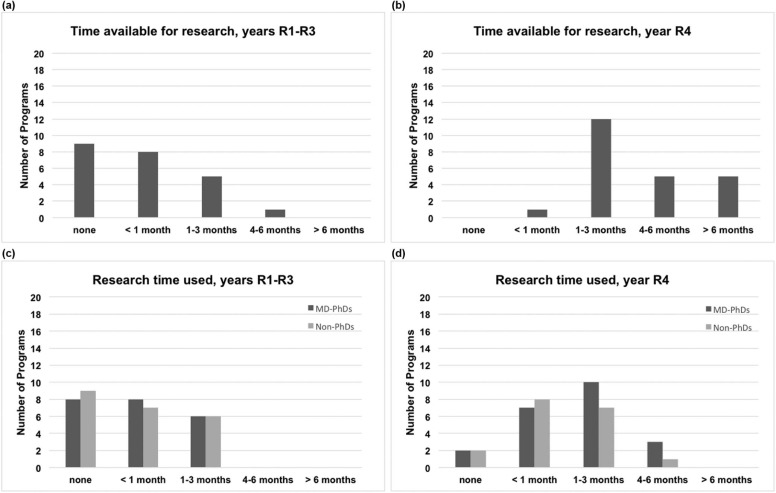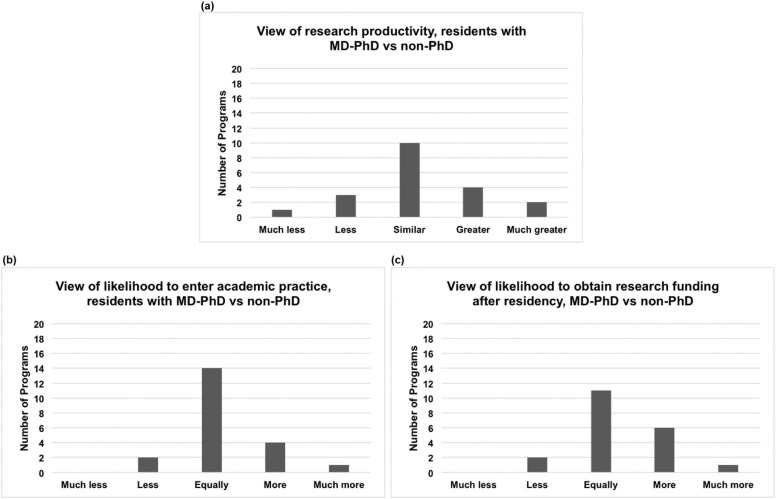Rationale and Objectives
The percentage of clinical scientists in radiology has historically been low. Increasing the pipeline of trainees interested in research could occur by recruiting MD-PhD trainees and providing protected research time during residency. The purpose of this work is to assess the attitudes of radiology program directors toward MD-PhD trainees, resident research productivity, and dedicated research time.
Methods
An online survey was sent to residency program directors of all diagnostic radiology departments that received National Institutes of Health (NIH) awards in 2014 ( n = 63). Survey questions included program size; perception of overall performance, clinical performance, and research productivity of MD-PhD residents compared to non-PhD residents; and presence of dedicated research time. Responses comparing MD-PhD residents to non-PhD residents were reported as a five-point Likert scale. Student t test was used to assess for significance (alpha = 0.05).
Results
Response rate was 37%. Clinical performance of MD-PhD residents was judged inferior ( P < .05) to non-PhD residents, although that of all residents engaged in research trended toward superiority compared to those not involved in research. Dedicated research time is offered by 61% of programs in years R1–R3 and all programs in year R4. Research productivity during residency was judged to be similar ( P = .5) between MD-PhD and non-PhD residents.
Conclusions
Survey results suggest that clinical performance during residency and research involvement is often individually based and difficult to generalize based on prior PhD training. All programs offered dedicated research time, and the vast majority of residents were reported to engage in research during residency, which may increase the pipeline of trainees interested in an academic career.
Introduction
Clinical scientists have declined in numbers in recent years , and the percentage of clinical scientists in radiology has historically been low, with approximately 20% of radiologists in an academic career . Choosing a career in academic radiology has been associated with prior training at an institution with top-ranking federal grant funding, participating in research during medical school or residency, publishing research manuscripts, and obtaining additional degrees (eg, PhD) . As such, one path toward an academic career is the Medical Scientist Training Program (MSTP), which provides integrated training in research and medicine, leading to a combined MD-PhD degree. The percentage of radiology residents with an MD-PhD, through the MSTP or alternate routes, was approximately 3% in 2015, and the percentage of matched radiology applicants with a PhD in 2016 was 5% . Reported barriers to MD-PhD graduates pursuing an academic career in radiology include historic lack of research time or income discrepancy between an academic and private practice career . Of the MSTP graduates who matriculate to radiology residency, 56% pursue careers as academic scientists, compared to 80% of MSTP graduates across all specialties and 20% of all radiology residents .
From these prior publications, one can draw that increasing the pipeline of trainees interested in research could occur by recruiting MD-PhD trainees, providing dedicated research pathways during residency, or by providing protected research time. The purpose of this work is to assess the attitudes of radiology program directors toward MD-PhD trainees, resident research productivity, and dedicated research time.
Methods
Get Radiology Tree app to read full this article<
Get Radiology Tree app to read full this article<
TABLE 1
Survey Questions. The Response Options Are Listed in Parentheses for Each Question
- What is the size of your radiology residency program? (small <21 residents, medium 21–32 residents, large >32 residents) 2. How many current radiology residents are MD-PhDs? (dropdown menu 0–25) 3. How do you view MD-PhD radiology residency applicants in general compared to non-PhD applicants? (positive, similar, negative) 4. How do you view MD-PhD radiology residency applicants compared to non-PhD applicants with a similar degree of research experience? (positive, similar, negative) 5. From your experience, how do MD-PhD residents perform clinically during residency compared to non-PhDs? (far superior, superior, comparable, inferior, far inferior) 6. From your experience, how do residents actively engaged in research perform clinically compared to those not involved in research? (far superior, superior, similar, inferior, far inferior) 7. From your experience, what is the research productivity of MD-PhD residents compared to non-PhD residents? (much greater, greater, similar, less, much less) 8. How much research time, off from clinical service, is available to radiology residents in years R1–R3? For this and subsequent questions, consider 1 day/week equivalent to 2 months/year. (none, <1 month, 1–3 months, 4–6 months, >6 months) 9. How much time is typically used by MD-PhD residents? (none, <1 month, 1–3 months, 4–6 months, >6 months) How much time is typically used by non-PhD residents? (none, <1 month, 1–3 months, 4–6 months, >6 months) 10. How much research time, off from clinical service, is available to radiology residents in year R4? (none, <1 month, 1–3 months, 4–6 months, >6 months) 11. How much time is typically used by MD-PhD residents? (none, <1 month, 1–3 months, 4–6 months, >6 months) How much time is typically used by non-PhD residents? (none, <1 month, 1–3 months, 4–6 months, >6 months) 12. Does your program offer a modified curriculum for MD-PhD residents or residents interested in pursuing research/a career in academics? (yes, no) 13. Does your program offer an option to pursue the Holman pathway? (yes, no) 14. In your experience, MD-PhD radiology residents are ______ likely to enter academics. (much more, more, equally, less, much less) 15. In your experience, MD-PhD radiology residents are _______ likely to obtain research funding after residency. (much more, more, equally, less, much less)
Get Radiology Tree app to read full this article<
Get Radiology Tree app to read full this article<
Results
Get Radiology Tree app to read full this article<
Get Radiology Tree app to read full this article<
Get Radiology Tree app to read full this article<
Get Radiology Tree app to read full this article<
Get Radiology Tree app to read full this article<
Get Radiology Tree app to read full this article<
Get Radiology Tree app to read full this article<
Get Radiology Tree app to read full this article<
Get Radiology Tree app to read full this article<
Discussion
Get Radiology Tree app to read full this article<
Get Radiology Tree app to read full this article<
Get Radiology Tree app to read full this article<
Get Radiology Tree app to read full this article<
Get Radiology Tree app to read full this article<
Acknowledgments
Get Radiology Tree app to read full this article<
Get Radiology Tree app to read full this article<
References
1. Straus S.E., Straus C., Tzanetos K.: Career choice in academic medicine: systematic review. J Gen Intern Med 2006; 21: pp. 1222-1229.
2. Grimm L.J., Shapiro L.M., Singhapricha T., et. al.: Predictors of an academic career on radiology residency applications. Acad Radiol 2014; 21: pp. 685-690.
3. Hillman B.J., Fajardo L.L., Witzke D.B., et. al.: Influences affecting radiologists’ choices of academic or private practice careers. Radiology 1990; 174: pp. 561-564. Available at: http://pubs.rsna.org/doi/pdf/10.1148/radiology.174.2.2296666
4. Association of American Medical Colleges : Data and analysis—AAMC. Available at: https://www.aamc.org/data/484720/report-on-residents-2017-b4table.html
5. National Resident Matching Program : Charting Outcomes in the Match for U.S. Allopathic Seniors Characteristics of U.S. Allopathic Seniors Who Matched to Their Preferred Specialty in the 2016 Main Residency Match. Main residency match data and reports; Available at: http://www.nrmp.org/main-residency-match-data/
6. Jeffe D.B., Andriole D.A., Wathington H.D., et. al.: Educational outcomes for MD-PhD program matriculants: a national cohort study. Acad Med 2014; 89:
7. Barry Julius : Radiology private practice versus other career pathways—is it worth “the extra money”?. RadsResident; Available at: http://radsresident.com/2017/03/26/radiology-private-practice-versus-other-career-pathways-is-it-worth-the-extra-money/
8. Brass L.F., Akabas M.H., Burnley L.D., et. al.: Are MD-PhD programs meeting their goals? An analysis of career choices made by graduates of 24 MD-PhD programs. Acad Med 2010; 85: pp. 692-701.
9. Andrea Fryear : What’s a good survey response rate?. SurveyGizmo; Available at: https://www.surveygizmo.com/survey-blog/survey-response-rates/



